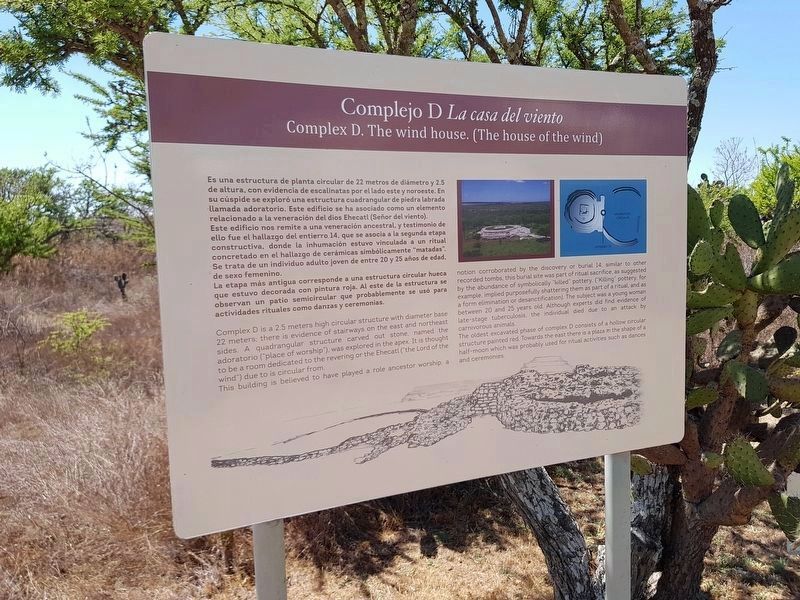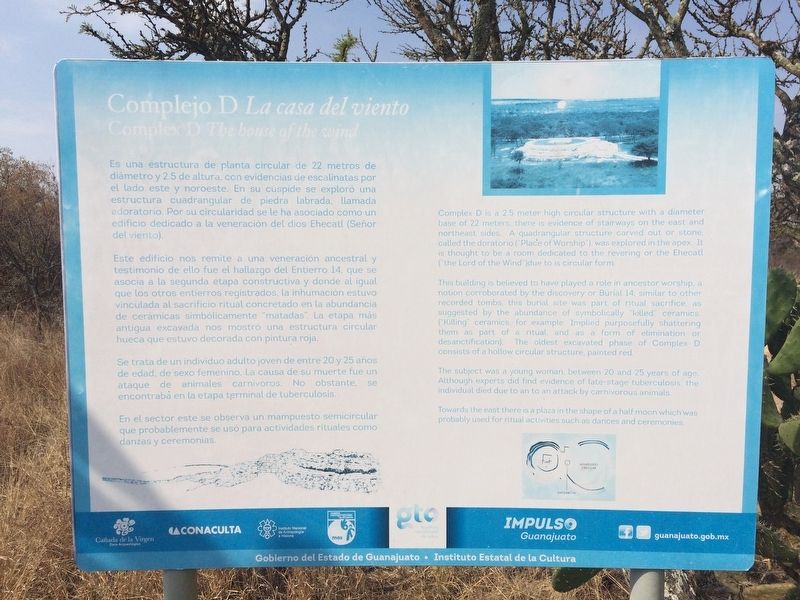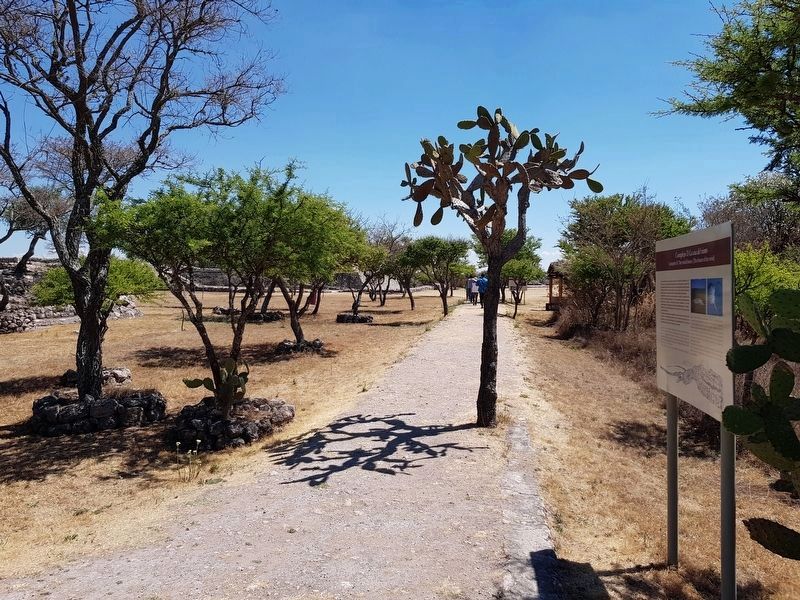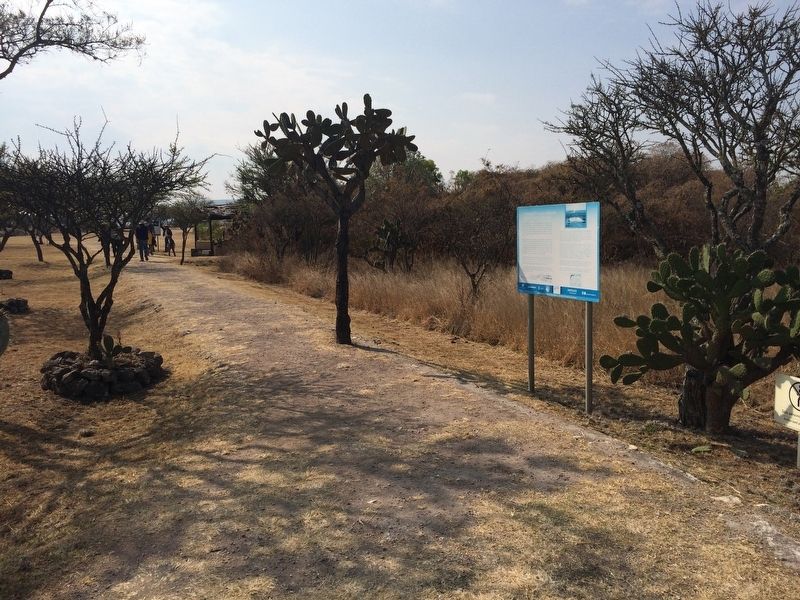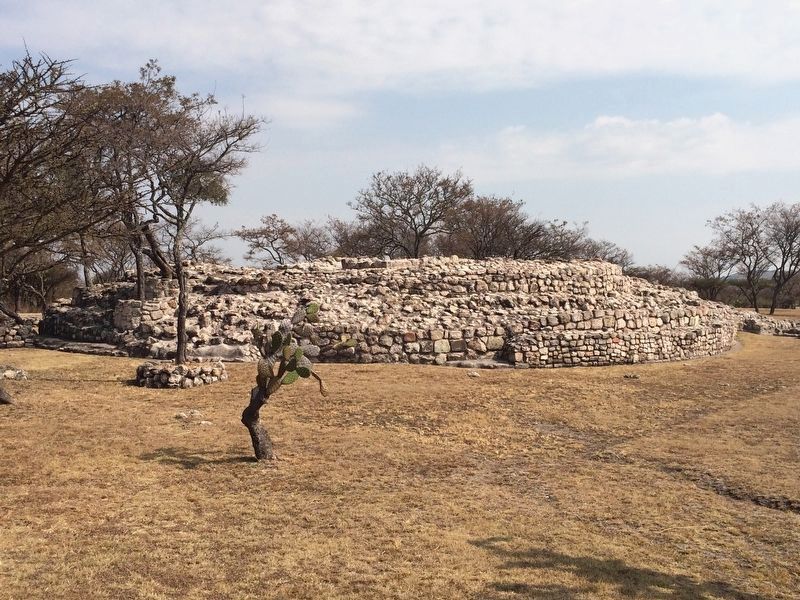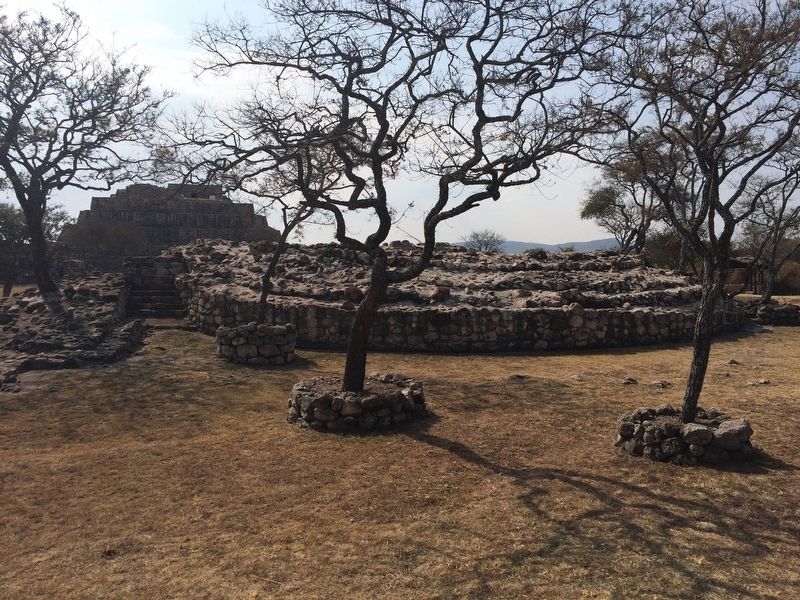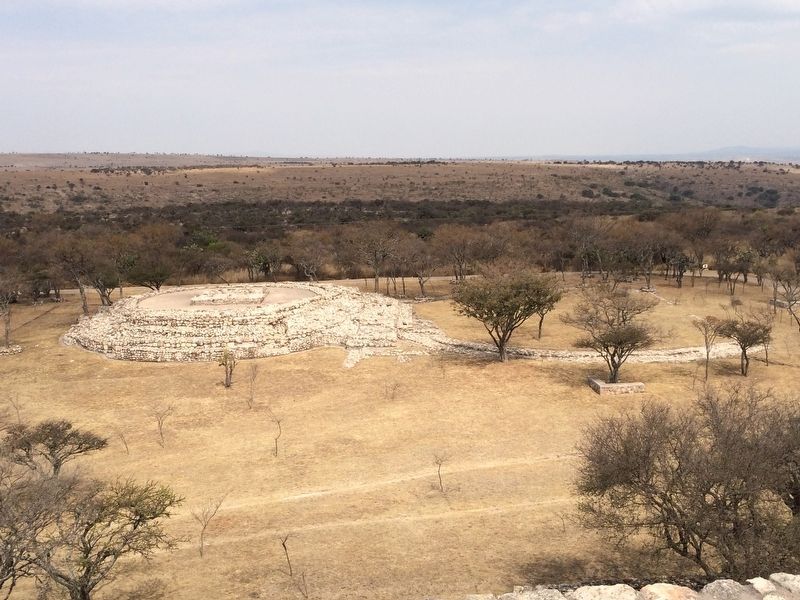Near San Miguel de Allende, Guanajuato, Mexico — The Central Highlands (North America)
Complex D. The wind house. (The house of the wind)
Inscription.
Complejo D La casa del viento
Es una estructura de planta circular de 22 metros de diámetro y 2.5 de altura, con evidencia de escalinatas por el lado este y noroeste. En su cúspide se exploró una estructura cuadrangular de piedra labrada, llamada adoratorio. Este edificio se ha asociado como un elemente relacionado a la veneración del dios Ehecatl (Señor del viento).
Este edificio nos remite a una veneración ancestral, y testimonio de ello fue el hallazgo del entierro 14, que se asocia a la segunda etapa constructiva, donde la inhumación estuvo vinculada a un ritual concretado en la abundancia de cerámicas simbolicamente “matadas”. Se trata de un individuo adulto joven de entre 20 y 25 años de edad, de sexo femenino.
La etapa más antigua corresponde a una estructura circular hueva que estuvo decorada con pintura roja. Al este de la estructura se observa un patio semicircular que probablemente se usó para actividades rituales como danzas y ceremonias.
English:
Complex D. The wind house. (The house of the wind)
Complex D is a 2.5 meter high circular structure with a diameter base 22 meters: there is evidence of stairways on the east and northeast sides. A quadrangular structure carved out stone, named the adoratorio (“place of worship”), was explored in the apex. It is thought to be a room dedicated to the revering or the Ehecatl (“the Lord of the Wind”) due to is (sic, its) circular form.
This building is believed to have played a role ancestor worship, a notion corroborated by the discovery or burial 14, similar to other recorded tombs, this burial site was part of ritual sacrifice, as suggested by the abundance of symbolically “killed” pottery. (“Killing” pottery, for example, implied purposefully shattering them as part of a ritual, and as a form elimination or desanctification). The subject was a young woman, between 20 and 25 years of age. Although experts did find evidence of late-stage tuberculosis, the individual died due to an to an attack by carnivorous animals.
The oldest excavated phase of complex D consists of a hollow circular structure painted red. Towards the east there is a plaza in the shape of a half-moon which was probably used for ritual activities such as dances and ceremonies.
Erected by Consejo Nacional para la Cultura y las Artes de México (CONACULTA)-INAH.
Topics. This historical marker is listed in these topic lists: Anthropology & Archaeology • Man-Made Features • Native Americans.
Location. 20° 51.54′
N, 100° 55.743′ W. Marker is near San Miguel de Allende, Guanajuato. The marker is to the right of Complex D at the archaeological site of Cañada de la Virgen. The Cañada de la Virgen is to the left when traveling north on State Road 67, some 30 km west of San Miguel de Allende. Touch for map. Marker is in this post office area: San Miguel de Allende GTO 37701, Mexico. Touch for directions.
Other nearby markers. At least 8 other markers are within walking distance of this marker. Layout and Architecture (within shouting distance of this marker); Burial 13 The hierarch and ancestral veneration (about 90 meters away, measured in a direct line); Complex B: The House of the Longest Night (about 120 meters away); Observing the Stars (about 120 meters away); Complex A The House of the Thirteen Heavens (about 120 meters away); Burial 18 The Decapitated Man (about 150 meters away); Cañada de la Virgen: A Ceremonial Civic Center in the Laja River Basin Marker (about 180 meters away); Ceremonial Road (about 210 meters away). Touch for a list and map of all markers in San Miguel de Allende.
Regarding Complex D. The wind house. (The house of the wind). The previous marker had the following text:
Complejo D La casa del viento
Es una estructura de planta circular de 22 metros de diámetro y 2.5 de altura, con evidencias de escalinatas por el lado este y noroeste. En su cúspide se exploró una estructura cuadrangular
de piedra labrada, llamada adoratorio. Por su circularidad se le ha asociado como un edificio dedicado a la veneración del dios Ehecatl (Señor del viento).
Este edificio nos remite a una veneración ancestral y testimonio de ello fue el hallazgo del Entierro 14, que se asocia a la segunda etapa constructiva y donde al igual que los otros entierros registrados, la inhumación estuvo vinculada al sacrificio ritual concretado en la abundancia de cerámicas simbolicamente “matadas”. La etapa más antigua excavada nos mostró una estructura circular hueca que estuvo decorada con pintura roja.
Se trata de un individuo adulto joven de entre 20 y 25 años de edad, de sexo femenino. La causa de su muerte fue un ataque de animales carnívoros. No obstante, se encontraba en la etapa terminal de tuberculosis.
En el sector este se observa un mampuesto semicircular que probablemente se usó para actividades rituales como danzas y ceremonias.
English:
Complex D The house of the wind
Complex D is a 2.5 meter high circular structure with a diameter base of 22 meters: there is evidence of stairways on the east and
northeast sides. A quadrangular structure carved out or stone called the adoratorio (“Place of Worship”), was explored in the apex. It is thought to be a room dedicated to the revering or the Ehecatl (“the
Lord of the Wind”) due to is (sic, its) circular form.
This building is believed to have played a role in ancestor worship, a notion corroborated by the discovery or Burial 14; similar to other
recorded tombs, this burial site was part of ritual sacrifice, as
suggested by the abundance of symbolically “killed” ceramics. (“Killing” ceramics, for example. Implied purposefully shattering them as part of a ritual, and as a form of elimination or desanctification). The oldest excavated phase of Complex D consists of a hollow circular structure, painted red.
The subject was a young woman, between 20 and 25 years of age. Although experts did find evidence of late-stage tuberculosis, the individual died due to an to an attack by carnivorous animals.
Towards the east there is a plaza in the shape of a half moon which was probably used for ritual activities such as dances and ceremonies.
Additional keywords. Complex D. The wind house. (The house of the wind)
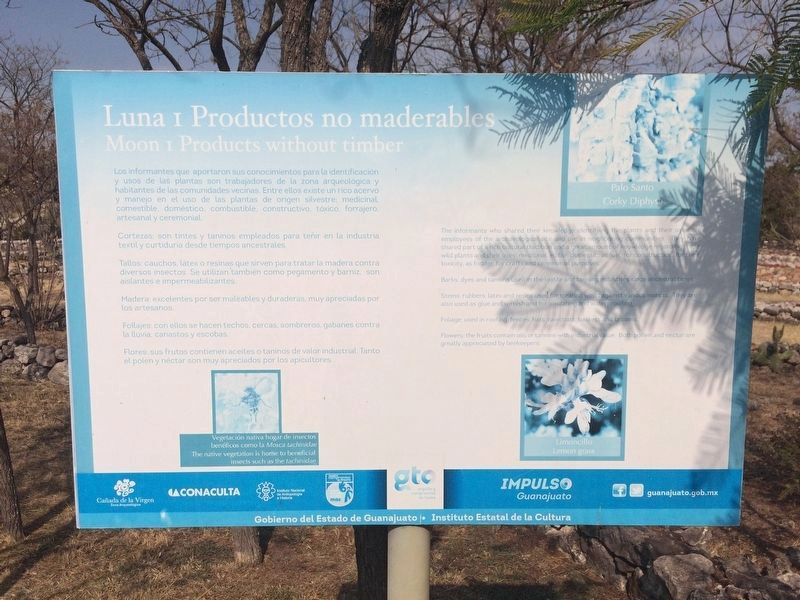
Photographed By J. Makali Bruton, February 5, 2017
8. A nearby marker describing natural products from the area.
Luna I Productos no maderables
Los informantes que aportaron sus conocimientos para la identificación y usos de las plantas son trabajadores de la zona arqueológica y habitantes de las comunidades vecinas. Entre ellos existe un rico acervo y manejo en el uso de las plantas de origen silvestre: medicinal, comestible, doméstico, combustible, constructivo, tóxico, forrajero, artesanal y ceremonial.
Cortezas son tintes y taninos empleados para teñir en la industria textil y curtiduría desde tiempos ancestrales.
Tallos: cauchos, látex o resinas que sirven para tratar la madera contra diversos insectos. Se utilizan también como pegamento y barniz, son aislantes e impermeabilizantes.
Madera: excelentes por ser maleables y duraderas, muy apreciadas por los artesanos.
Follajes: con ellos se hacen techos, cercas, sombreros, gabanes contra la lluvia, canastos y escobas.
Flores: sus frutos contienen aceites o taninos de valor industrial. Tanto el polen y nectar son muy apreciados por los apicultores.
Pie de dibujos:
Palo santo
Limoncillo
Vegetación nativa hogar de insectos benéficas como la Mosca tachinidae
English:
Moon I Products without timber
The informants who shared their knowledge identifying the plants and their uses are employees of the archaeological site and live in neighboring communities. They have shared part of a rich cultural tradition and a great amount of knowledge regarding these wild plants and their uses: medicinal, edible, domestic, as fuel, for construction, for their toxicity, as fodder, for crafts and ceremonial purposes.
Barks: dyes and tannins used in the textile and tanning industries since ancestral times.
Stems: rubbers, latex and resins used for treating wood against various insects. They are also used as glue and varnish and for insulating and waterproofing.
Foliage: used in roofing, fences, hats, raincoats, baskets and brooms.
Flowers: the fruits contain oils or tannins with industrial value. Both pollen and nectar are greatly appreciated by beekeepers.
Captions:
Corky Diphysa
Lemon grass
The native vegetation is home to beneficial insects such as the tachinidae
Credits. This page was last revised on September 1, 2020. It was originally submitted on June 6, 2017, by J. Makali Bruton of Accra, Ghana. This page has been viewed 126 times since then and 7 times this year. Photos: 1. submitted on November 10, 2019, by J. Makali Bruton of Accra, Ghana. 2. submitted on June 6, 2017, by J. Makali Bruton of Accra, Ghana. 3. submitted on November 10, 2019, by J. Makali Bruton of Accra, Ghana. 4, 5, 6, 7, 8. submitted on June 6, 2017, by J. Makali Bruton of Accra, Ghana.
